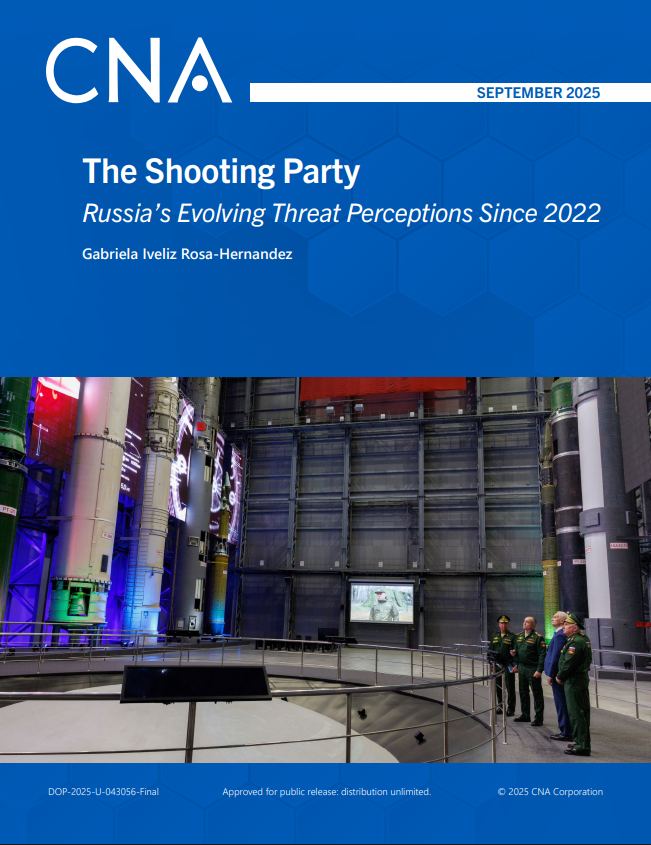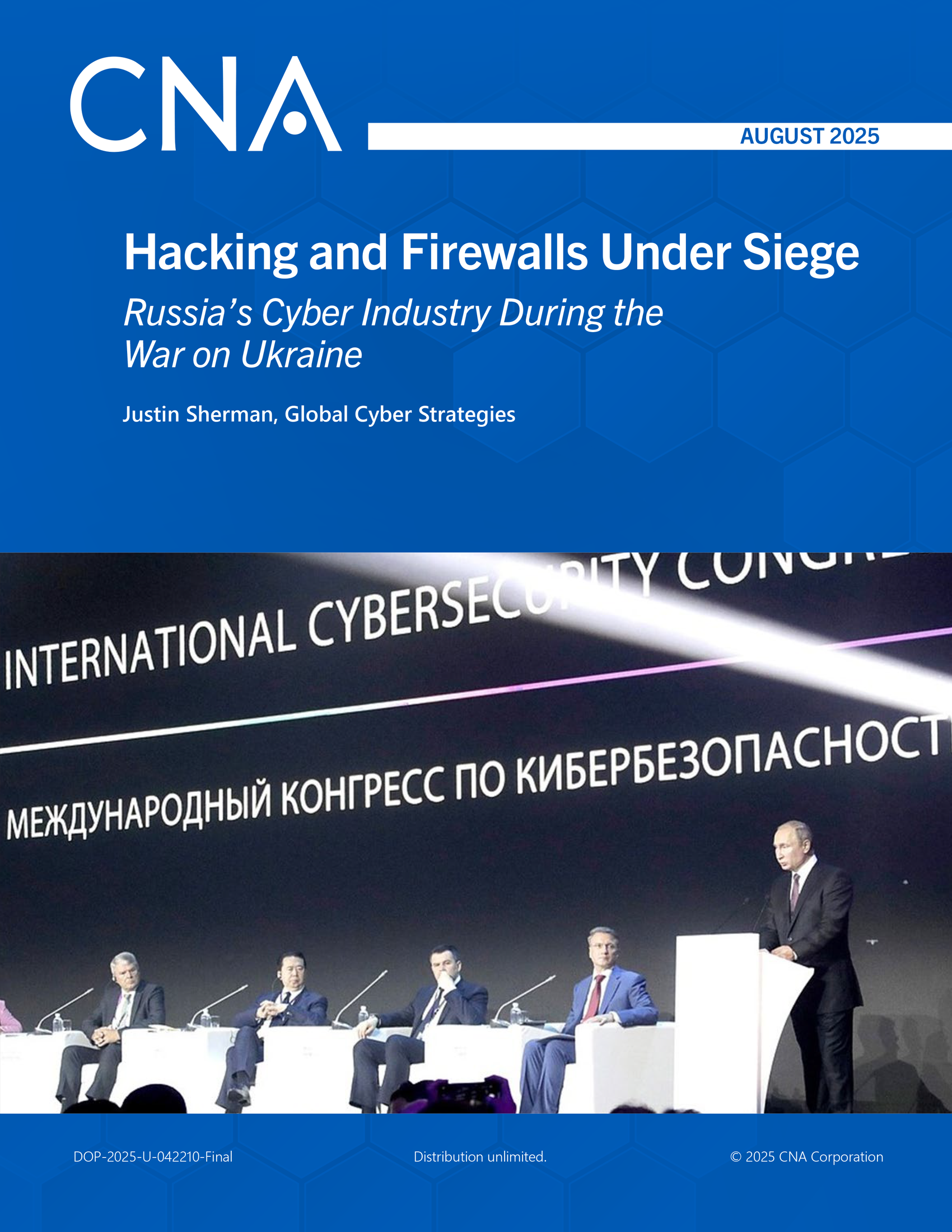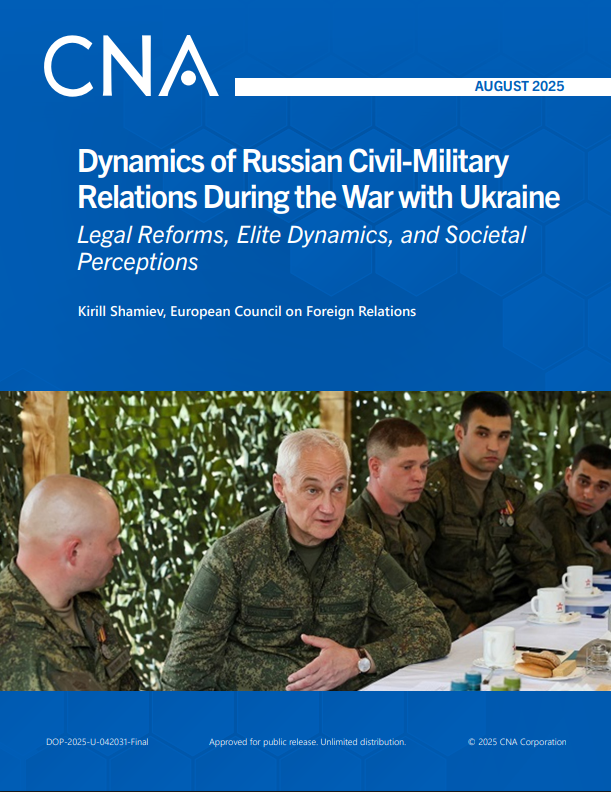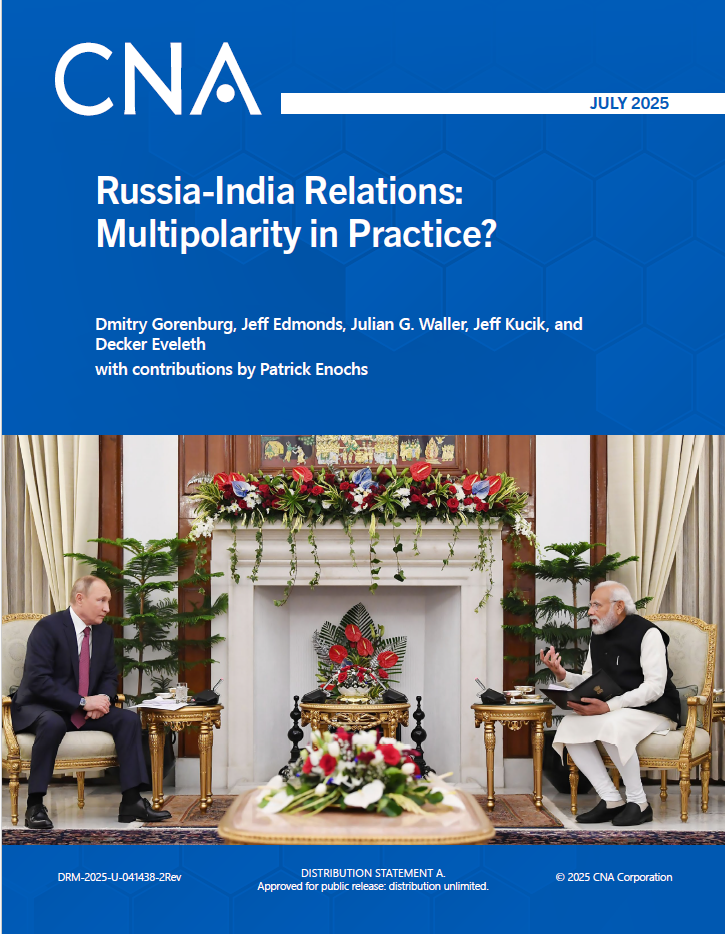Executive Summary
This report examines the evolution of Russian thinking about military strategy and conventional military operations after three years of conflict in Ukraine. It assesses Russian elite military thought on combined arms operations, naval surface warfare, and air dominance operations (including long-range precision strike). It probes the thinking of Russian military elites on how the country’s military strategy and operational concepts should evolve to address emerging changes in the character of armed conflict in anticipation of future wars.
The study begins with an analysis of Russian strategic thought, which forms the foundation for Russian warfighting concepts. It then discusses three main operational areas: combined arms operations, naval surface warfare, and air dominance operations. In each of these areas, the Russian military has encountered major unexpected challenges during the war, including the inability to wage effective combined arms offensives, maintain control of the Black Sea, and achieve air dominance. The study team drew primarily from leading Russian military journals, such as Voennaia Mysl’ (Military Thought), which are widely read by Russian political and military elites. We also consulted materials published by leading Russian think tanks and central newspapers providing expert coverage of Russian military affairs as well as Russian official doctrine.
Key findings
The report finds that despite significant technological advances, which in turn have led to major tactical changes in the character of armed conflict (especially widespread use of uncrewed systems), Russian strategic and operational thinking on conventional military operations remains largely unchanged from approaches adopted before the war. Instead, for most Russian military elites, the war appears to confirm prewar conclusions regarding the character of armed conflict, despite the unexpected setbacks incurred by Russian forces during the war. Consequently, Russian views on the character of armed conflict have evolved little since the war, and there are no signs of any fundamental shifts in Russian strategic concepts or operational doctrine.
Russian military elites have chosen to address emerging military challenges with a peculiar mixture of confirmation bias and technological fetishism. In essence, they argue that their concepts were correct all along and that the failure of the Russian military in Ukraine is mainly due to poor planning and operationalization of valid and long-standing concepts combined with massive and unforeseen Western support for Ukraine. Although poor training has also played a role, Russian military thinkers have offered little at the operational level of war to indicate that systemic improvements in training are needed to help resolve these failures. The solution to these challenges, they argue, lies in adopting advanced technology such as artificial intelligence, next-generation uncrewed systems, and appropriate tactical innovations. Few if any military experts make references to rethinking their wartime strategic or operational concepts.
Russian elite thinking about combined arms operations highlights this approach. Military thinkers readily acknowledge the inability of Russia’s Ground Forces to conduct effective combined arms maneuver during the war, characterized by rapid breakthrough and exploitation operations led by tanks and motorized infantry. But they tend to attribute this outcome to the emergence of ubiquitous intelligence, surveillance, and reconnaissance (ISR) and the proliferation of mass and precision fires. These conditions, they claim, have led to the emergence of a “transparent battlefield” in which Russian formations are unable to concentrate, maneuver, and conduct deep operations without being instantly detected and targeted by mass and precision fires with disabling effect. Yet, far from abandoning their prewar doctrine, Russian elites are focused mainly on restoring the army’s ability to maneuver by increasing the force size and suppressing adversary ISR and strike capabilities in response to new battlefield conditions.
Likewise, Russian naval experts are grappling with the challenges encountered by Russia’s Black Sea Fleet during the war and their implications for future conflicts at sea. These include the fleet’s failure to maintain sea control and the loss of numerous Russian warships. Even though Ukraine lacks a traditional navy, its armed forces have succeeded in countering Russia’s surface fleet using uncrewed surface vessels and precision missiles. Yet, despite the seeming intractability of these challenges, Russian military elites remain focused on restoring the fleet’s ability to seize and maintain local sea control and fulfill key missions. To achieve this aim, they are advocating primarily for tactical and technological measures to enhance ship survivability, suppress adversary ISR, and counter adversary missile and drone strikes in lieu of serious revisions to operational art.
Likewise, the successes and failures of Russia’s Aerospace Forces during the war have spurred much introspection among Russian air power theorists. Yet ideas about Russian air dominance operations have not fundamentally shifted away from pre- 2022 themes either. Although Russian writers have identified strengths and weaknesses in the Aerospace Forces and proposed a variety of responses, they have yet to alter their general assessments on the character of air warfare, and they have not proposed fundamental changes in air strategy, doctrine, or concepts. Instead, to address the problems encountered in Ukraine for future conflicts, Russian air power theorists are focused on increasing the force size and relying on advanced technology, to include enhancements to Russia’s ground-based air defenses and long-range strike capabilities. Yet Russian thinking about suppression and destruction of enemy air defenses operations remains moribund despite the air force’s failure to seize air control over Ukraine, with all its attendant consequences.
Implications
Given Russia’s lack of major doctrinal revisions at both the strategic and the operational levels, Russia continues to frame its strategic competition with the West in many of the same ways that it did before 2022. It is still preparing for war with the North Atlantic Treaty Organization with most of the same assumptions and ideas in mind. Its theory of victory still rests on setting conditions for success during the Threatening Period, deploying rapid and overwhelming force during the Initial Period, imposing costs via strategic defense and long-range strikes, maintaining escalation dominance, and undermining the adversary’s will to fight.
The Ukraine war’s protraction, the failure of Russia’s strike campaign to break Ukrainian will, and Russia’s loss of escalation credibility have had little impact on the Russian military’s formulation of ideas. Combined arms warfare, the value of naval surface operations, the centrality of air dominance, and the fundamental war-winning importance of long-range precision strike have all proven to be surprisingly durable ideas given Russian failures in the war. As the Russian military begins to reconstitute over the next decade, it will likely do so with these concepts in mind.
Thus, Russian military elites have not embraced attritional warfare, nor have they abandoned or fundamentally altered naval surface war concepts. They continue to rely on long-range precision strike as a potentially war-winning capability, embrace ground-based air defense as an asymmetric advantage, and envision a combined arms maneuver force operating on a broken battlefield. Despite the armed forces’ record in the war, the Russian military remains extremely capable and very dangerous.
The implications of these ideas for any potential adversary are significant. Russia’s reliance on the Initial Period of War as a strategic linchpin means that nations must continue to develop advanced systems capable of providing strategic and tactical indications and warning. Operationally, the high likelihood of long-range precision attack against critical military, economic, and civilian targets means that states must take measures to ensure increased resilience in the Initial Period of War and beyond. Furthermore, Russian theorists are pushing for ground operations to be rapid and dynamic, so Western military planners should expect their adversary to seek to avoid grinding attrition warfare in a future conflict. In the maritime domain, Russian theorists argue for a combination of dense, active near-seas defense combined with long-endurance stealthy platforms for use in the far seas. These platforms will all be equipped with long-range precision strike for offensive and defensive cost imposition.
Consequently, given these projections and assuming more limited objectives in a different region (such as the Baltic), a Russian military that in five years looks and operates similarly to the one in 2025 may very well achieve its strategic military objectives in a future conflict.
Download reportApproved for public release: distribution unlimited.
Details
- Pages: 74
- Document Number: DRM-2025-U-041457-1Rev
- Publication Date: 8/5/2025





